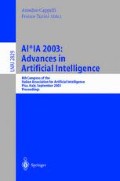Abstract
A novel, two stage, neural architecture for the segmentation of range data and their modeling with undeformed superquadrics is presented. The system is composed by two distinct neural stages: a SOM is used to perform data segmentation, and, for each segment, a multi-layer feed-forward network performs model estimation. The topology-preserving nature of the SOM algorithm makes this architecture suited to cluster data with respect to sudden curvature variations. The second stage is designed to model and compute the inside-outside function of an undeformed superquadric in whatever attitude, starting form the (x,y,z) data triples. The network has been trained using backpropagation, and the weights arrangement, after training, represents a robust estimate of the superquadric parameters. The modelling network is compared also with a second implementation, which estimates separately the parameters of the 2D superellipses generating the 3D model. The whole architectural design is general, it can be extended to other geometric primitives for part-based object recognition, and performs faster than classical model fitting techniques. Detailed explanation of the theoretical approach, along with some experiments with real data are reported.
Access this chapter
Tax calculation will be finalised at checkout
Purchases are for personal use only
Preview
Unable to display preview. Download preview PDF.
References
Barr, A.H.: Superquadrics and Angle-preserving Transformations. IEEE Computer Graphics and Applications 1, 11–23 (1981)
Biederman, I.: Recognition-by-components: A theory of human image understanding. Psychological Review 94(2), 115–147 (1987)
Dickinson, S.J., Pentland, A.P., Rosenfeld, A.: 3-D Shape Recovery Using Distributed Aspect Matching. IEEE Trans. on Pattern Analysis and Machine Intelligence 14(2), 174–198 (1992)
Edelman, S.: Representation is representation of similarities. Behavioral & Brain Sciences 21, 449–498 (1998)
Edelman, S., Poggio, T.: Bringing the grandmother back into the picture: A memory-based view of object recognition. A.I. Memo 1181. MIT, Cambridge (1991)
Ferrie, F.P., Lagarde, J., Whaite, P.: Darboux Frames, Snakes, and Super- Quadrics: Geometry From the Bottom Up. IEEE Trans. on Pattern Analysis and Machine Intelligence 15(8), 771–784 (1993)
Fritzke, B.: Growing Cell Structures — A Self-Organizing Network for Unsupervised and Supervised Learning. Neural Networks 7(9), 1441–1460 (1994)
Hummel, J.E., Biederman, I.: Dynamic binding in a neural network for shape recognition. Psychological Review 99, 480–517 (1992)
Kohonen, T.: The Self–Organizing Map. Proceedings of the IEEE 78(9), 1464–1480 (1990)
Leonardis, A., Jaklic, A., Solina, F.: Superquadrics for Segmenting and Modeling Range Data. IEEE Trans. on Pattern Analysis and Machine Intelligence 19(11), 1289–1295 (1997)
Levenberg, K.: A method for the solution of certain non-linear problems in least squares. Quarterly Journal of Applied Mathematics II(2), 164–168 (1944)
MacQueen, J.: Some methods for classification and analysis of multivariate observations. In: Le Cam, L.M., Neyman, J. (eds.) Proc. of the 5th Berkeley Symposium on Mathematical Statistics and Probability, Berkeley, CA, vol. 1, pp. 281–297. University of California Press, Berkeley (1967)
Marquardt, D.W.: An algorithm for least-squares estimation of non-linear parameters. Journal of the Society of Industrial and Applied Mathematics 11(2), 431–441 (1963)
Marr, D.: Vision. W.H. Freeman & Co, New York (1982)
Møller, M.: A scaled conjugate gradient algorithm for fast supervised learning. Neural Networks 6(4), 525–533 (1993)
Paul, R.: Robot Manipulators. MIT Press, Cambridge (1981)
Pentland, A.P.: Perceptual organization and the representation of natural forms. Artificial Intelligence 28, 293–331 (1986)
Pentland, A.P.: Recognition by Parts. In: Proc. of International Conference on Computer Vision, London, pp. 612–620 (1987)
Pirrone, R.: Part based Segmentation and Modeling of Range Data by Moving Target. Journal of Intelligent Systems 11(4), 217–247 (2001)
Rumelhart, D.E., Hinton, G.E., Williams, R.J.: Learning ingternal representations by error propagation. In: Rumelhart, D.E., McClelland, J.L., PDP Research Group (eds.) Parallel Distributed Processing: Explorations in the Microstructure of Cognition. Foundations, vol. 1, pp. 318–362. MIT Press, Cambridge (1986)
Solina, F., Bajcsy, R.: Recovery of parametric models from range images: The case for superquadrics with global deformations. IEEE Trans. on Pattern Analysis and Machine Intelligence 12(2), 131–147 (1990)
Ullman, S.: High-level Vision: Object Recognition and Visual Cognition. MIT Press, Cambridge (1996)
Ullman, S., Basri, R.: Recognition by linear combinations of models. IEEE Trans. on Pattern Analysis and Machine Intelligence 13, 992–1006 (1991)
Whaite, P., Ferrie, F.P.: From Uncertainty to Visual Exploration. IEEE Trans. on Pattern Analysis and Machine Intelligence 13(10), 1038–1049 (1991)
Author information
Authors and Affiliations
Editor information
Editors and Affiliations
Rights and permissions
Copyright information
© 2003 Springer-Verlag Berlin Heidelberg
About this paper
Cite this paper
Pirrone, R., Chella, A. (2003). A Neural Architecture for Segmentation and Modelling of Range Data. In: Cappelli, A., Turini, F. (eds) AI*IA 2003: Advances in Artificial Intelligence. AI*IA 2003. Lecture Notes in Computer Science(), vol 2829. Springer, Berlin, Heidelberg. https://doi.org/10.1007/978-3-540-39853-0_11
Download citation
DOI: https://doi.org/10.1007/978-3-540-39853-0_11
Publisher Name: Springer, Berlin, Heidelberg
Print ISBN: 978-3-540-20119-9
Online ISBN: 978-3-540-39853-0
eBook Packages: Springer Book Archive

